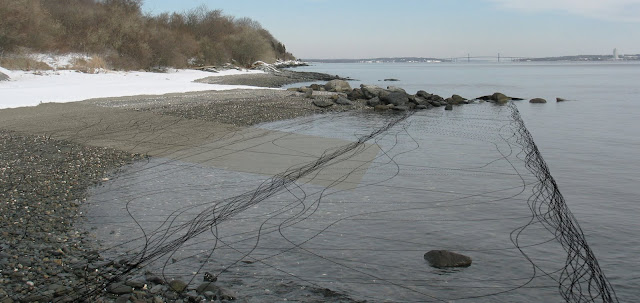abstract
Along the shoreline of Prudence Island, on the site of a former United States Naval Base, a series of abandoned bunkers form a cultural infrastructure within a larger ecological network of coastal wetlands. As a dynamic edge, the dissolving terrain of the coast creates a fluid environment in which the nature of resources must be critically examined. By framing this condition, first perceptually and then physically, the edge becomes spatial while continuing to fluctuate as an active condition. Upon closer investigation of this natural coastal process two distinct edge conditions emerge, each with a particular scale of time and space: the tidal edge and the fresh/saltwater edge. This landscape becomes an active field addressing both transitory and bound conditions. In order to defend the cultural and ecological habitats present on site, topographical interventions reinterpret the traces of the Naval Base as a cultural structure to facilitate the framing of edge conditions on multiple scales.
thesis terms
The following terms outline the ideas critical to the development of my thesis:
FLUID
1. an aqueous substance capable of changing states.
2. adaptable and flexible.
NATURAL PROCESSES
a systematic series of actions existing in or produced by nature.
an outgrowth, projection or course, as of time.
TERRAIN
the surface area of land considered by its natural features.
a continuous topography which connects a landform to its context.
EDGE
a line or border at which two things meet.
a spatial and dynamic boundary.
FRAME
a structural reference, particular to place and perception.
an expanding boundary.
FLUID
1. an aqueous substance capable of changing states.
2. adaptable and flexible.
NATURAL PROCESSES
a systematic series of actions existing in or produced by nature.
an outgrowth, projection or course, as of time.
TERRAIN
the surface area of land considered by its natural features.
a continuous topography which connects a landform to its context.
EDGE
a line or border at which two things meet.
a spatial and dynamic boundary.
FRAME
a structural reference, particular to place and perception.
an expanding boundary.
epigraph
I feel I exist on the boundaries
Somewhere between science and art / art and architecture / public and private / east and west
I am always trying to find a balance between these opposing forces, / finding the place where opposites meet.
Water out of stone / glass that flows like water / the fluidity of a rock / stopping time
Existing not on either side / but on the line that divides / and that line takes on a dimensionality / it takes on a sense of place and shape.
Somewhere between science and art / art and architecture / public and private / east and west
I am always trying to find a balance between these opposing forces, / finding the place where opposites meet.
Water out of stone / glass that flows like water / the fluidity of a rock / stopping time
Existing not on either side / but on the line that divides / and that line takes on a dimensionality / it takes on a sense of place and shape.
Maya Lin, Boundaries
draft thesis statement
Islands are terrain bound into a single landform by water--a boundary which is constantly shifting and dissolving in connection with ecological and cultural conditions. On an island, water both literally and metaphorically surrounds, even transcends, culture. On an island, water frames all natural processes and defines specific ecologies. At the same time, the bound condition defines a particular set of limits based on limited resources and rising sea levels. In order to be self-sustaining entities, natural and cultural processes must acknowledge a critical balance between where systems transcend the edge and where they are contained by it. In this regard the dynamic edge of the shoreline becomes a significant space for culture and ecologies where they are either held of released into their greater context.
Subscribe to:
Comments (Atom)

